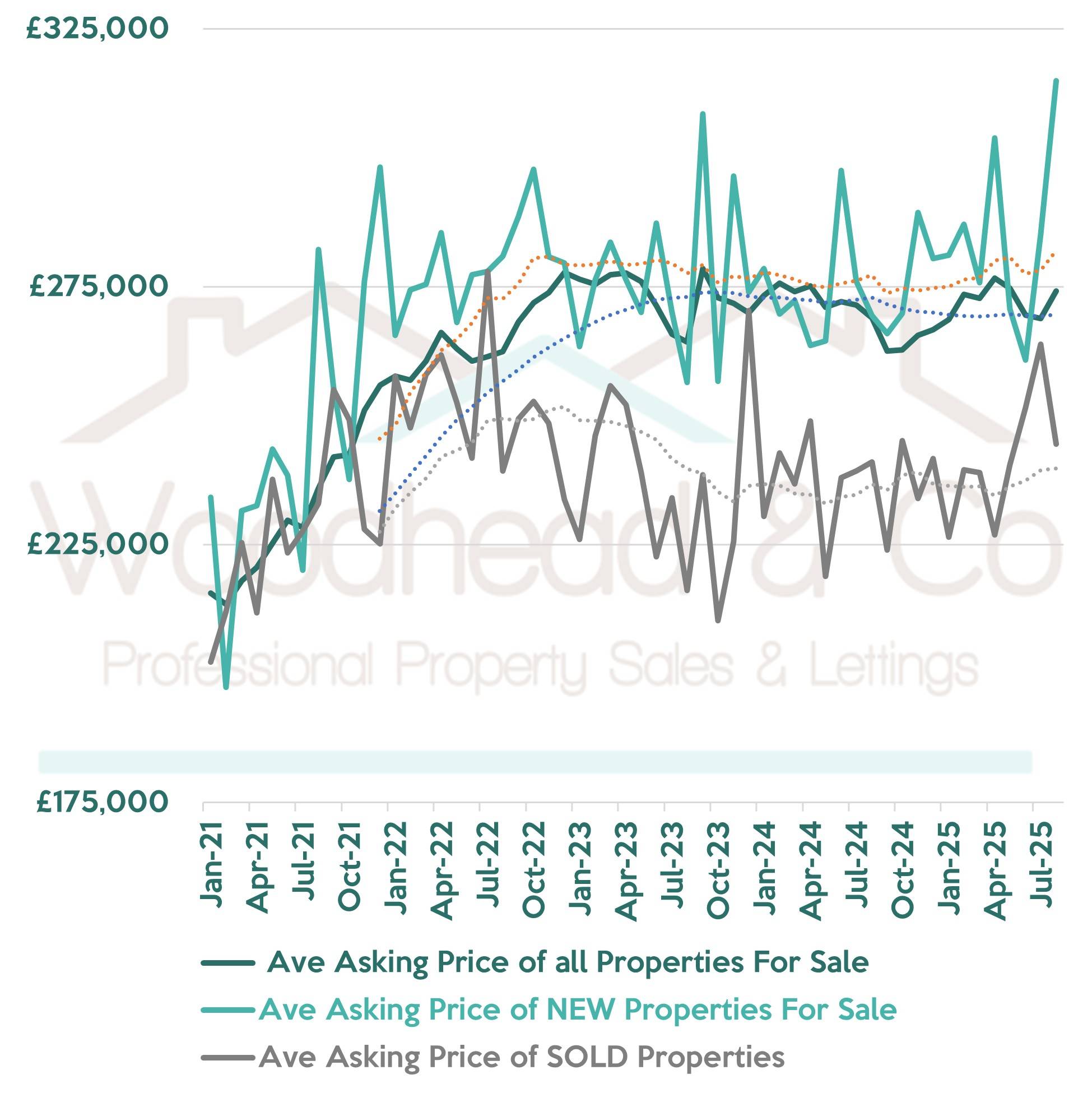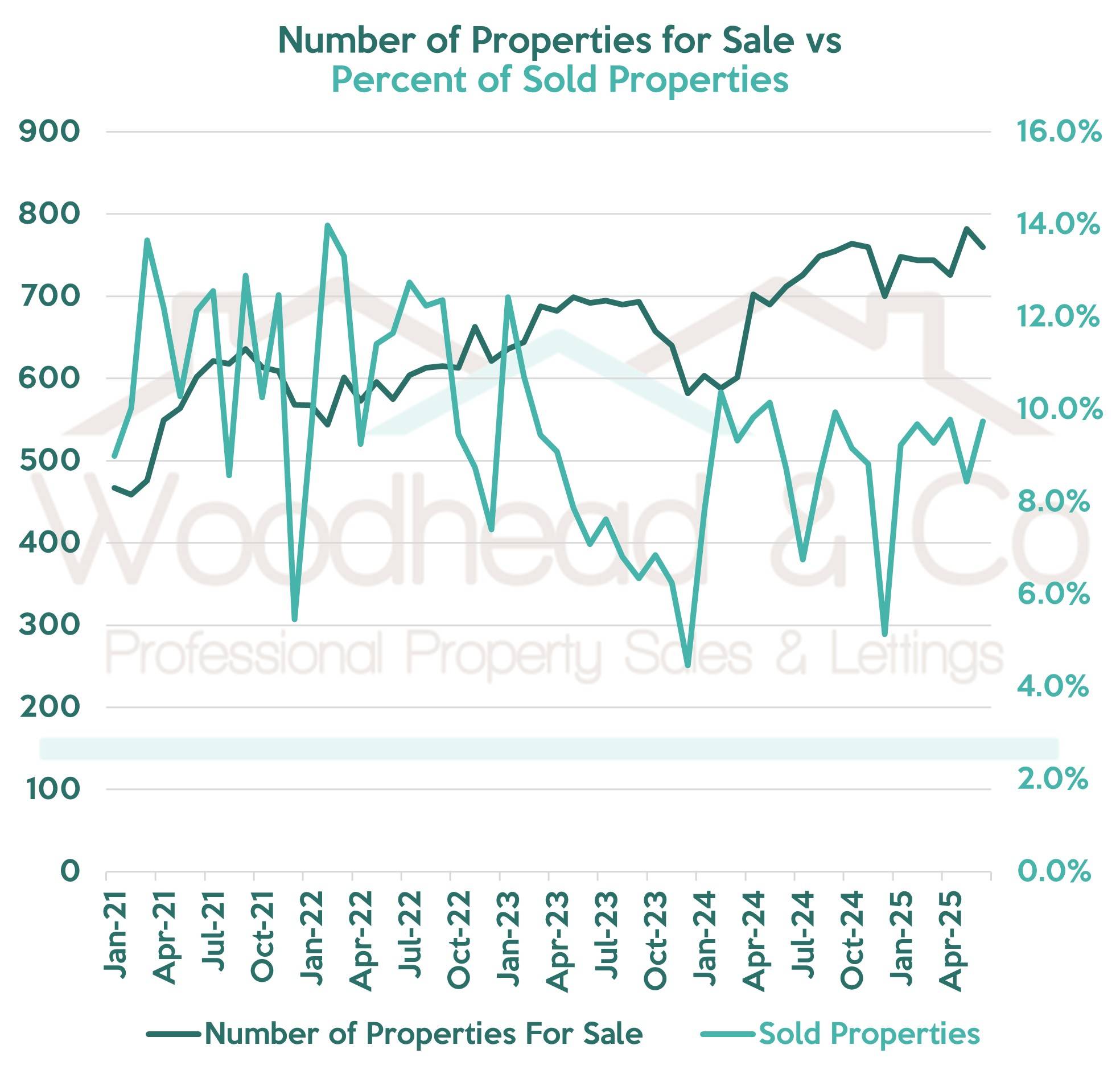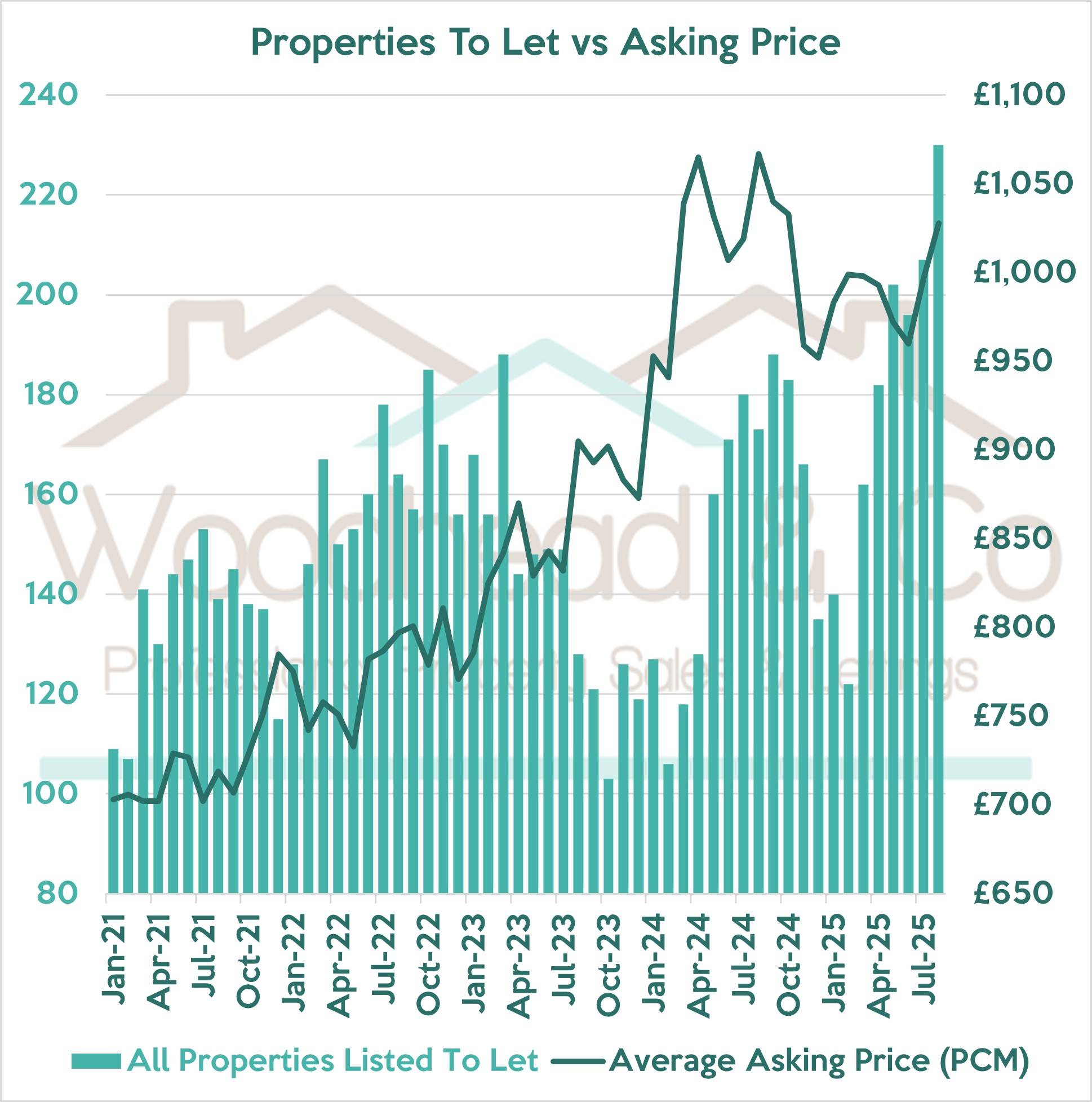After a bumpy summer, Wellingborough’s housing market enters September showing signs of renewed seller confidence, though with more subdued buyer activity than we saw in spring.
The average asking price of all properties in August 2025 rose to £274,197, up from £268,878 in July — a monthly increase of £5,319 (+1.98%). This rebound recovers nearly all the value lost in June, when prices dipped by over £5,000, and puts asking prices just £3,521 below their all-time high of £277,718 (May 2022).

Zooming in, we see a familiar pattern: newly listed properties in August averaged £278,122, up £17,272 (+6.6%) on the month — the largest single-month increase since early 2022. This signals renewed optimism among sellers, even as buyer sentiment appears more cautious. By contrast, the average asking price of sold properties dipped slightly to £256,507, down from £261,771 in July (-2.0%).
This divergence between asking and achieved prices has widened again, with the gap now standing at £21,615, the second-largest margin seen in the past two years. While sellers are listing high, buyers remain price-sensitive — a pattern that’s persisted since late 2022.
To put current pricing in context:
If asking prices were to fall 5%, they’d sit around £260,487 (comparable to July 2025 levels).
A 10% reduction would bring them to £246,777, similar to October 2022 figures.
Looking at stock levels, 803 properties were listed for sale in August — a slight dip from July’s 814, but still one of the highest levels seen since 2021. Available stock remains elevated, which may be holding prices steady for now, despite some signs of seasonal slowdown.
However, the number of properties marked as sold dropped again — falling to 7.6% of total listings, down from 9.1% in July. This marks the lowest sales rate since January 2024 and continues a 3-month slide. Though not yet alarming, it’s a clear indicator that buyer momentum has cooled since the spring peak.
In summary, while sellers remain bullish, buyers are hesitating — perhaps in anticipation of better deals later this year. With autumn around the corner and mortgage rates still above 5%, the next few months will be crucial in determining whether the market steadies… or begins to shift.
The major property commentators have recently released their autumn forecasts — and the message is clear: stability and modest recovery are the most likely paths forward.
Zoopla (August 2025) reports that house price falls have largely bottomed out, with UK prices now just 0.1% below last year. They forecast price growth of 2–3% nationally over the next 12 months, driven by improved affordability and steady demand in affordable regions. Source
Savills (September 2025) anticipates a +3.5% UK-wide price rise in 2026, with the Midlands expected to outperform due to relative affordability and inward investment. Wellingborough, with its rail links and regeneration, is firmly in that camp. Source
Nationwide (August 2025) notes a return of buyer confidence as inflation drops and mortgage approvals rise. They expect prices to be flat to +2% by mid-2026, but emphasise regional variation. Source
Halifax (July 2025) sees slow but sustained growth returning, with a 2% increase in prices forecast for the next 12 months. They cite wage growth and pent-up demand as key drivers. Source
These expert insights align with what we’re observing locally: while sellers must still price competitively to attract interest, the worst of the price drops appears to be behind us. With more buyers returning and mortgage rates continuing to ease, Wellingborough’s market looks increasingly well-positioned for a measured rebound into 2026.
After months of fluctuation, the Wellingborough rental market has taken a confident stride forward. The average asking rent in September 2025 rose to £1,070 PCM, marking a new all-time high since we began tracking in January 2021. This represents a £64 monthly increase compared to August (£1,006), and a significant year-on-year jump of £149 (compared to £921 in September 2024).

Meanwhile, the number of homes listed to let also surged to 235 — the highest level since our records began. That’s up from 197 in August and 178 in September 2024. While rental stock levels have been historically tight in recent years, this sudden uplift is one of the clearest indicators yet that landlords are returning to the market — or that some tenants are moving on and triggering more churn.
To put current pricing into context:
If average rents were to fall by 5%, they’d return to £1,016 PCM — a level last seen in May 2025.
A 10% drop would bring them to £963 PCM, roughly matching the market in December 2024.
September’s spike in rental prices and listings marks one of the most significant month-on-month movements we’ve seen in the Wellingborough rental market in the past two years. The sudden £64 jump in average rent coinciding with a dramatic increase of 38 properties listed to let raises two key questions: why now, and will it continue?
Firstly, seasonal trends offer part of the answer. September is traditionally one of the most active months in the lettings calendar. Families settle before school term starts, university students move into rental homes, and professionals often time relocations post-summer. This natural churn creates temporary surges in both listings and rent prices.
However, this year’s movement seems larger than usual. One reason could be a resurgence in landlord activity. With inflation now falling and mortgage rates stabilising, many landlords who paused investments due to uncertainty or tax burdens are reassessing their options. For those holding fixed-rate mortgages or who secured lower rates earlier, the current environment offers strong yields and growing demand — especially in high-growth towns like Wellingborough.
There’s also a growing narrative that tenant affordability has reached a tipping point. As wages struggle to keep pace with rent inflation, more tenants may be opting to move, downsize, or share housing to manage costs. This increases the number of properties coming to market, albeit not necessarily from new landlord instructions.
Additionally, the broader economic mood has shifted. Consumer confidence is returning, and with it, greater mobility. This mobility boosts churn in the market — tenants move more, landlords list more, and rents edge upward as demand intensifies.
Taken together, this suggests September 2025 may be the start of a new phase in the local lettings market — not just a seasonal bump. It will be important to monitor October and November data to see whether this is the beginning of a sustained upward trend or a short-term peak fuelled by post-summer pressures.
Several major commentators have recently updated their rental forecasts:
Zoopla (August 2025) expects UK rents to rise 6% over the next 12 months, with high-demand regional towns like Wellingborough likely to outpace national averages. Source
JLL (Summer 2025) forecasts cumulative rental growth of 20% by 2028, driven by long-term supply constraints and strong demand. Source
Savills (Q3 2025) predicts rents will continue to rise faster than inflation, especially in commuter towns outside London. Source
These insights align with what we’re seeing on the ground: a fiercely competitive market where demand still outpaces supply — even when stock levels rise.
📊 Data source: Zoopla Pro
Subscribe to receive the latest property market information to your inbox, full of market knowledge and tips for your home.
You may unsubscribe at any time. See our Privacy Policy.